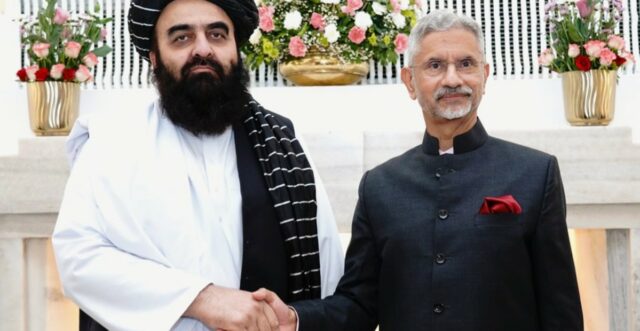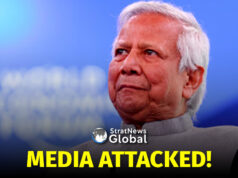Afghan Foreign Minister Amir Khan Muttaqi’s arrival in New Delhi on October 9, 2025, just two days after attending the Moscow Format on Afghanistan, marked a decisive inflection in South Asia’s geopolitical calculus. His visit culminated in the upgradation of India’s technical mission to a full-fledged embassy in Kabul and the launch of a direct India-Afghanistan air freight corridor, underscoring a clear departure from Pakistan’s long-standing influence over Kabul.
Muttaqi’s stop at Darul Uloom Deoband added a deeply symbolic dimension. There, he was conferred the honorary title “Qasmi” and a Hadith Sanad, granting him authority to teach Hadith, an extraordinary recognition for a foreign cleric. The gesture reflected India’s move from political to theological diplomacy, reclaiming the moderate Hanafi–Deobandi narrative from Pakistan’s Wahhabi radicalism. It also signalled that India’s engagement with Afghanistan was not merely transactional but civilizational.
The Moscow Format: Regional Consensus For Stability
Just days earlier, on October 7, 2025, the Moscow Format consultations on Afghanistan brought together Russia, China, Iran, Pakistan, India and the Central Asian republics in a rare show of regional alignment. The joint statement categorically declared that “any attempts to deploy foreign military infrastructure in Afghanistan or neighboring states are unacceptable”, a direct rebuttal to U.S. President Donald Trump’s call to “retake Bagram Airbase.”
With Russia’s formal recognition of the Islamic Emirate, the Taliban participated for the first time as a full member. The message was unambiguous: Afghanistan’s destiny must be shaped by its neighbours, and engagement, rather than isolation, is the pathway to regional stability. Moscow has thus positioned itself as the convener of a new Eurasian consensus, one that increasingly aligns with India’s calibrated approach toward Kabul.
Operation Sindoor: Recalibrating Deterrence
New Delhi’s diplomatic reactivation followed the strategic reverberations of Operation Sindoor, India’s cross-border counter-terror strike in May 2025. Launched in retaliation for the Pahalgam terror attack, the operation targeted militant infrastructure and leadership deep inside Pakistan. Army Chief General Upendra Dwivedi described it as a “decisive and surgical response”. Executed with precision on May 6, without civilian or military casualties, the strikes reflected India’s doctrine of credible deterrence with calibrated restraint.
The operation redefined regional perceptions, exposing Pakistan’s internal vulnerabilities and reinforcing India’s capacity for proportional response. Kabul and Moscow both took note: India was no longer a reactive actor but a strategic balancer combining resolve with responsibility.
Pakistan’s Internal Fragility
While India consolidates its strategic position, Pakistan faces an unravelling within. From Pakistan-occupied Kashmir (PoK) to Balochistan, unrest has intensified. The Baloch Yakjehti Committee reports escalating protests over enforced disappearances and economic neglect, met with heavy-handed crackdowns. In PoK, public anger over taxes, electricity shortages and governance failures has laid bare Islamabad’s weakening authority.
Economically, Pakistan remains on life support—IMF-dependent, burdened by inflation and crippled by chronic energy deficits. Meanwhile, a resurgent Tehrik-e-Taliban Pakistan (TTP) has conducted over 600 attacks in 2025 alone, claiming more than 2,500 lives since 2021. These overlapping crises—economic, political and security—reveal a fractured state struggling to manage its contradictions, even as India demonstrates growing strategic coherence.
Afghanistan’s Strategic Autonomy
Amid Pakistan’s decline, the Taliban regime has begun asserting strategic autonomy. With the end of two decades of war and the U.S. withdrawal, Kabul’s foreign policy has pivoted toward regional integration. India’s pragmatic engagement and the Taliban’s participation in the Moscow Format signal a deliberate decoupling from Islamabad’s traditional tutelage.
Muttaqi’s visit produced a joint assurance that Afghan territory would not be used against India, a breakthrough in bilateral trust. New Delhi responded by expanding cooperation in health, education, mining, and infrastructure—anchored by the new air corridor bypassing Pakistan. The Deoband engagement added ideological depth, re-rooting Afghan Islam within its Hanafi–Deobandi tradition, distinct from Pakistan’s militarised Wahhabism.
India’s Development Footprint: Risk, Resilience And Respect
India’s presence in Afghanistan has always been defined by risk and resilience. Even during the most violent years between 2001 and 2021, Indian engineers, doctors and diplomats served under constant threat. They endured attacks yet continued their mission, earning deep respect among ordinary Afghans.
- On July 7, 2008, a suicide bombing at the Indian embassy in Kabul killed four Indians, including a senior diplomat and the Defence Attaché and 60 Afghans.
- In February 2010, coordinated hotel attacks in Kabul claimed nine Indian lives, including doctors and two Army officers.
- Indian engineers working on projects like the Zaranj–Delaram Highway were abducted, killed or targeted repeatedly in provinces such as Farah, Nimroz and Zabul.
These sacrifices forged a bond of trust that transcends governments and regimes. Over two decades, India invested over $3 billion in reconstruction—the largest contribution by a regional power. From the Afghan Parliament and power lines to hospitals, schools, and roads, scholarships for Afghan students in India, India’s development footprint has touched every sphere of Afghan life.
Cricket, Culture And Civilisational Ties
Cricket, a shared passion, has emerged as a bridge of hearts between the two nations. India’s investment in Afghan cricket, hosting the national team and integrating Afghan players into the IPL, has transformed sport into a vector of diplomacy. Figures like Rashid Khan have become household names, embodying friendship and mutual admiration.
This cultural affinity extends beyond sport. From Tagore’s “Kabuliwala”, which immortalised Afghan warmth in Indian memory, to Bollywood’s enduring popularity in Kabul, the people-to-people connection remains profound. Hindi cinema and Indian television dramas have long offered Afghans a window into Indian life stories of family, morality and hope that have endured even amid war and censorship. These civilizational linkages, rooted in shared emotion and narrative, continue to underpin Afghan goodwill toward India.
India’s Strategic Imperatives
The convergence of deterrence, diplomacy, and soft power presents India with a historic opportunity to redefine its Afghan strategy. The roadmap ahead must rest on five interlinked pillars:
- Post-Sindoor Deterrence: Maintain intelligence dominance and operational readiness to deter terrorism while avoiding escalation.
- Deepened Diplomatic Engagement: Transition from humanitarian relief to strategic cooperation in education, healthcare, intelligence sharing and infrastructure.
- Connectivity through Chabahar and Air Corridors: Strengthen trade links bypassing Pakistan, connecting India with Afghanistan and Central Asia.
- Strategic Economic Partnerships: Mobilise public-private investment in Afghanistan’s mining and energy sectors, building economic interdependence.
- Religious and Ideological Outreach via Deoband: Promote moderate Deobandi-Hanafi scholarship to counter radical Wahhabism and stabilise the theological centre.
Regional Consensus Building: Coordinate with Russia, Iran and Central Asia to stabilise Afghanistan and prevent Pakistan’s manipulation of Afghan territory.
Conclusion: Strategic Clarity In A Fractured Region
The post-Sindoor landscape offers India an unprecedented moment of strategic clarity. Through a calibrated blend of deterrence, diplomacy and cultural engagement, New Delhi can redefine its role not just in Afghanistan but across Eurasia.
Muttaqi’s visit to Deoband, the restoration of India’s embassy in Kabul and the rise of Afghan cricket symbolise a quiet realignment accompanied by the erosion of Pakistan’s influence, the assertion of Afghan sovereignty and India’s emergence as a stabilising regional force.
India’s strength lies not only in its military resolve but in its capacity to shape narratives, connect civilisations and build trust. By intertwining hard power with cultural diplomacy, New Delhi positions itself not as a transient actor but as the region’s indispensable stabiliser.
The essence of India’s Afghan playbook rests on a trinity: Deterrence, Diplomacy and Deoband—a synthesis of power, principle and persuasion defining India’s civilisational approach in a shifting regional order.
(The author is a geopolitical analyst and strategic advisor who writes on South Asia, multipolarity and civilisational statecraft. Views expressed in this article are personal.)





